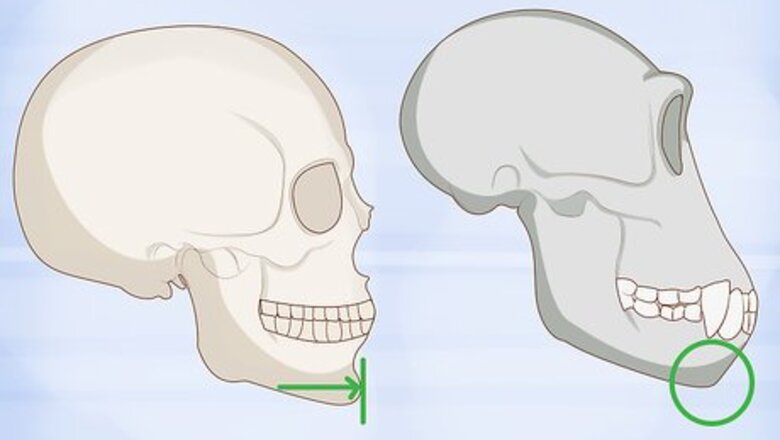
views
Distinguishing Cranial Bones
Look for a relatively large, bulbous skull in humans. Human brains are large relative to the size of our heads, so our skulls generally look bulbous next to the face. Alternatively, animal skulls tend to be more curved, since they house a smaller brain. Animal skulls will have larger faces in comparison to the skull. If you find a skull, you're not sure about, call the police.
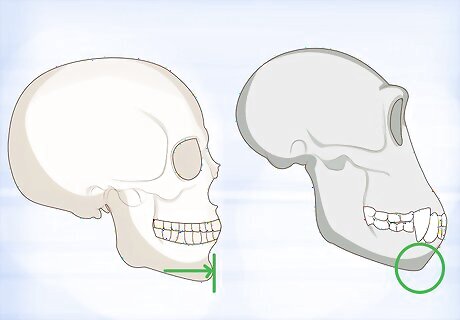
Check for a chin to identify a human skull. Most animals do not have a chin. When you're examining a skull, look closely to see if it has a chin extending from the front of the skull at the bottom. If it does, it's likely human. If not, it's likely an animal.
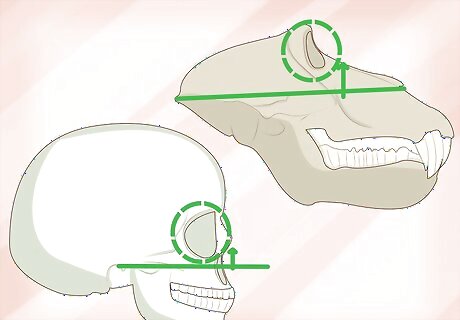
Look for eyes above the nose in humans. Humans have the orbits (eye sockets) to the front, above the nose. On the other hand, animals' orbits are to the side and behind the nose. You should be able to distinguish this feature on a skull by examining how the eye sockets are situated in the skull. Also, check for how far the nose and face extend outward. In animals, the nasal area extends much farther out than in humans.
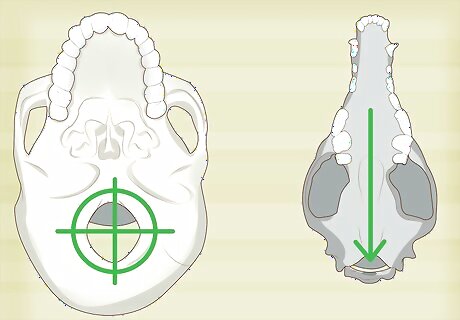
See if the skull would sit above or in front of the spinal column. Look for the hole at the base of the skull. This hole is called the foreman magnum, and it's how the spinal column connects to the brain. Because humans stand upright, the hole is more centrally located underneath the skull. In other mammals, the hole is further back, since they typically hold their bodies more parallel to the ground. Think about how humans walk versus how a dog or even a gorilla walks for instance. The human head extends straight upward from the shoulder, while a dog or gorilla head comes up at an angle. If you think about where the connection point would be, you'll be able to establish where the hole should be on each animal.
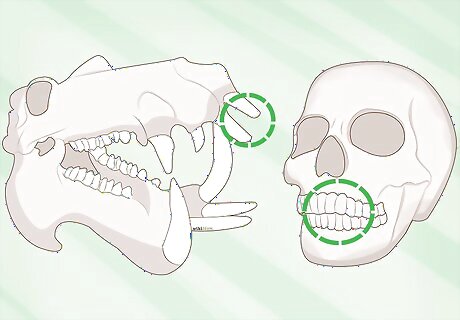
Check for small canines in the mouth for humans. The canines are the pointy, fang-like teeth. Since humans are omnivores, the canines will be present like other meat-eaters. However, human canines tend to be smaller than those of most predators/carnivores, which have long, cone-shaped canines. Herbivores, animals that eat only vegetation, will have very small canines or none at all. Also, with the exception of horses, humans have larger incisors than other mammals. The incisors are the straight-edged teeth at the very front of the mouth.
Checking Torso Bones

Look for a dish-shaped pelvis in human remains. Because humans are bipedal, the pelvis is shaped differently than it is in most other animals. It is shorter, and it has a bowl shape. On the other hand, other animals typically have longer pelvises that are more blade-like. It's easiest to tell the difference when you view the pelvis from the side. An animal pelvis will be thinner, almost flat. A human pelvis is much wider from the side with curved bones. It almost extends fully across the body from front to back. The wide human pelvis provides support to the upper body, helping humans to walk upright.
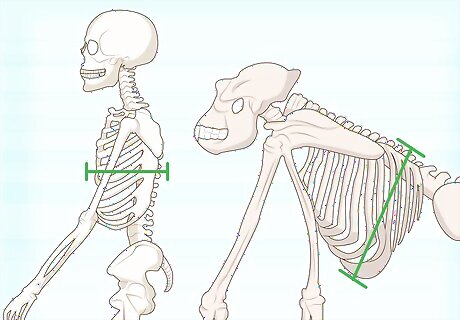
Notice a flatter rib cage in human remains. While the pelvis is wider in humans, the rib cage is actually narrower. This feature pulls the center of gravity back toward the spine, helping humans stand upright. In other animals, the ribcage tends to be much wider and rounder. For instance, the width of an ape's rib cage extends down almost to the elbow as they walk. If you hold your arms out in front of you, you'd see that your rib cage doesn't extend nearly that far.
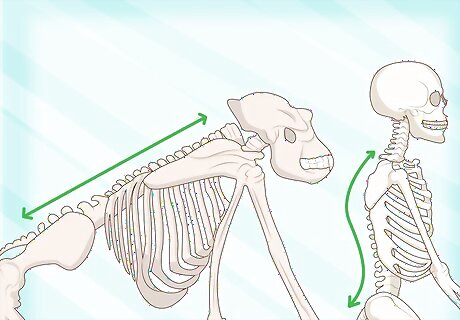
Check the spine for 3 curves to identify humans. Because humans walk upright, the spine curves in 3 places, like an "S." Most animals have a straighter spine. For instance, an ape spine extends along their back in a straight line, as they support the weight of their body on both their legs and arms. This curved shape helps the body absorb shock and keeps the head upright.
Examining the Limbs
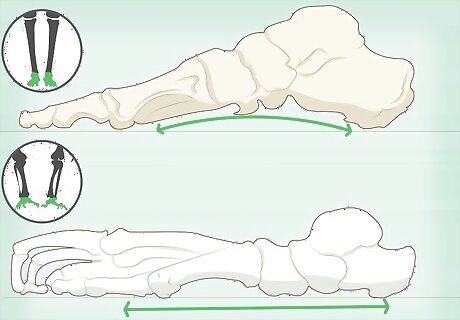
Look for the arched foot in humans. A human foot has an arch underneath, which helps propel the body forward each step, as it acts like a spring. Animals like apes have flat feet, as they grasp the ground with their toes. The arch is kept in place by ligaments. Also, the big toe on an ape face outward, perpendicular from the other toes. In a human, all of the toes go in the same direction. In addition, humans bear weight on the whole foot, which is why it is long and narrow. Other animals mainly bear weight on their toes.
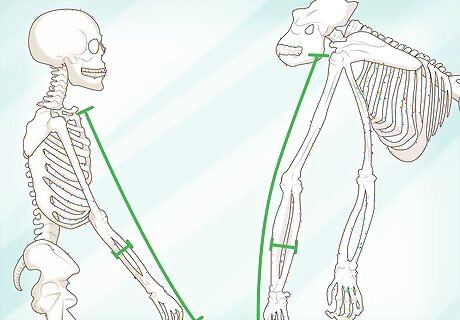
Notice smaller upper limbs in humans. Other animals walk on all fours, which is why they tend to have larger bones in their arms than humans. Humans don't bear weight on their arms, so the bones don't have to be as large. For instance, an ape or even a horse bears weight on all 4 legs, so the upper limbs are more developed.

Check to see if the femur is the longest bone in the body for humans. Because humans walk upright, the thigh bone, otherwise known as the femur, is the longest, strongest bone in the body. On the other hand, the femur will be the same length as other bones in animals. Look for the long bone starting just above the knee and extending up towards the pelvis.

Look for separate bones in the calf. The 2 calf bones, the tibia and fibula, are separate in humans. In other animals, these 2 bones are often fused together. Check these bones and see if they are a single bone or 2 bones to identify animal or human remains.
Looking at the Inside of the Bone

Check for a less dense cortical bone in humans. The cortical bone is the dense outside layer of the bone. Humans, though, tend to have less dense cortical bones than animals do. The area is more porous.
Look for the cortical area to be 1/4 the thickness of the whole bone. In a long bone, like the femur or humerus bone, look at a cross section. In a human, the outer cortical layer will only make up about 1/4 of the area of the bone. Because animals' bones are denser, the cortical area will make up about 1/2 of the thickness of the bone. To look at a cross section, you will need to find a bone that's broken or cut one to look inside it. If you're not sure whether the bone is animal or human, you should definitely call the police before cutting into it.

Notice small holes in the inside of the bone. The inside cavity of the bone is called the medullary. In humans, this area typically has small holes in it, called trabecula. Animals, on the other hand, usually don't have these small holes. The inside cavity is often smooth. Similarly, the inside of the human skull will look spongy. On the other hand, something like a sun-bleached turtle shell can look like human skull when it's in pieces, but it won't be spongy inside the bone.










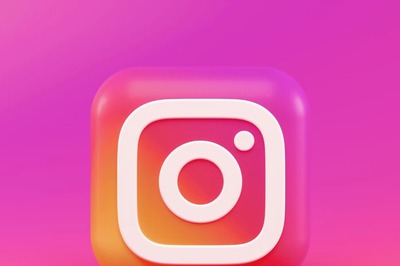




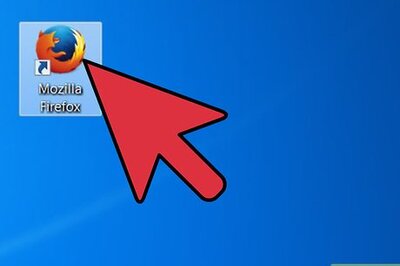
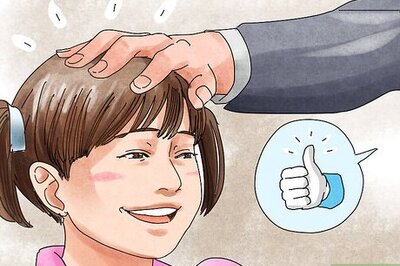



Comments
0 comment